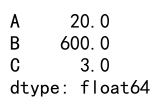Pandas agg mean
Pandas is a powerful Python library for data manipulation and analysis. It provides numerous functions to perform complex operations on data sets with ease. In this article, we will delve deep into the use of the agg (aggregate) function and the mean function, exploring how they can be used to summarize data efficiently. We will provide detailed examples to demonstrate the versatility and utility of these functions.
Introduction to Pandas
Pandas provides high-performance, easy-to-use data structures, and data analysis tools. The primary data structure in Pandas is the DataFrame, which can be thought of as a table of data with rows and columns.
The mean Function
The mean function in Pandas is used to calculate the arithmetic mean of a given set of numbers. It is commonly used in data analysis to find the central value of a numeric dataset.
Example 1: Basic Usage of mean
import pandas as pd
# Create a DataFrame
data = {'Values': [10, 20, 30, 40, 50]}
df = pd.DataFrame(data)
# Calculate the mean of the DataFrame
mean_value = df['Values'].mean()
print(mean_value)
Output:

The agg Function
The agg function, short for aggregate, is a powerful tool in Pandas that allows you to apply one or more operations over the specified axis. It is extremely useful for applying multiple aggregations on a DataFrame or Series.
Example 2: Using agg with a Single Function
import pandas as pd
# Create a DataFrame
data = {'Values': [10, 20, 30, 40, 50]}
df = pd.DataFrame(data)
# Use agg to calculate the mean
result = df.agg('mean')
print(result)
Output:

Example 3: Using agg with Multiple Functions
import pandas as pd
# Create a DataFrame
data = {'Values': [10, 20, 30, 40, 50]}
df = pd.DataFrame(data)
# Use agg to calculate mean and standard deviation
result = df.agg(['mean', 'std'])
print(result)
Output:

Detailed Examples of agg and mean
Example 4: Aggregating Multiple Columns
import pandas as pd
# Create a DataFrame
data = {
'A': [10, 20, 30],
'B': [100, 200, 300]
}
df = pd.DataFrame(data)
# Aggregate multiple columns
result = df.agg('mean')
print(result)
Output:

Example 5: Aggregating Over Rows
import pandas as pd
# Create a DataFrame
data = {
'A': [1, 2, 3],
'B': [4, 5, 6]
}
df = pd.DataFrame(data)
# Aggregate over rows
result = df.agg('mean', axis=1)
print(result)
Output:

Example 6: Using agg to Compute Multiple Statistics
import pandas as pd
# Create a DataFrame
data = {
'A': [10, 20, 30],
'B': [100, 200, 300]
}
df = pd.DataFrame(data)
# Compute multiple statistics
result = df.agg(['mean', 'sum', 'max'])
print(result)
Output:

Example 7: Chain agg with Other Operations
import pandas as pd
# Create a DataFrame
data = {'Values': [10, 20, 30, 40, 50]}
df = pd.DataFrame(data)
# Chain aggregation with filtering
result = df[df['Values'] > 20].agg('mean')
print(result)
Output:

Example 8: Aggregating with a Dictionary
import pandas as pd
# Create a DataFrame
data = {
'A': [10, 20, 30],
'B': [100, 200, 300],
'C': [1, 2, 3]
}
df = pd.DataFrame(data)
# Define aggregation rules
agg_rules = {'A': 'mean', 'B': 'sum', 'C': 'max'}
# Apply aggregation
result = df.agg(agg_rules)
print(result)
Output:

Pandas agg mean conclusion
The agg and mean functions in Pandas are essential tools for data analysis, allowing for efficient summarization and transformation of data. Through the examples provided, we have seen how these functions can be applied in various scenarios to derive meaningful insights from data. Whether you are aggregating multiple columns, applying custom functions, or chaining operations, Pandas provides the flexibility and power to handle complex data analysis tasks with ease.
 Pandas Dataframe
Pandas Dataframe